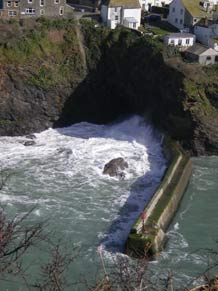
Port Isaac, Cornwall. Photo: Dr Larissa Naylor.
Britain’s wildlife will benefit from better coastal structures
Plants and animals that live on Britain’s coasts could benefit from changes to the way coastal structures such as seawalls, breakwaters, rock armour and jetties are designed and built.
Research by the Universities of Exeter and Plymouth and Treweek Environmental Consultants, supported by the Environment Agency, has led to the development of recommendations for the design and construction of coastal defence structures.
The team has produced guidance on how the ‘ecological enhancement’ of hard coastal structures can be embedded in the design and planning process, from conception through to construction.
Past research has found that hard structures are poor ecological substitutes for natural rocky shores, often supporting only a few dominant, opportunistic species such as green algae. The research team assessed the suitability of different materials, surface roughness, positioning and height for coastal habitats. They examined structures across the South West coast, including Ilfracombe in Devon and Newlyn in Cornwall, as well as looking further afield to work from Sydney Harbour in Australia and Seattle Harbour in the USA. They focused on organisms such as barnacles and limpets as these dominate many rocky shore environments and rapidly colonise hard surfaces placed in the sea, including harbour walls. Once these organisms have established themselves, other plants and animals typically follow, to the benefit of species such as salmon.
Results demonstrate that small changes such as adding a rough surface to a concrete structure can help create a haven for wildlife. Such changes don’t affect the integrity of the defence structure, nor do they incur a significant cost, but they can make a huge difference to the number and type of species that can colonise.
Geographer Dr Larissa Naylor of the University of Exeter (Cornwall Campus) said: “Coastal defence structures are essential in protecting people, homes and businesses from flooding and erosion. However, they also impact on the biodiversity of our coastlines. This will become even more important as these risks increase as a result of climate change and more hard coastal infrastructure is required in certain locations.
“We have shown that by making small changes, such as producing surfaces that are rough rather than smooth, or leaving niches in sea walls, we can ensure these structures support much more wildlife.”
The Environment Agency is now sharing the guidance with staff, who are considering how it can be used in future coastal developments.
David Baxter, Head of Catchment Management and Coastal Environment for the Environment Agency said: "We needed guidance on the scientific evidence, policy drivers, different types of tried and tested enhancement techniques, and how to get them designed into hard coastal defences and approved through the planning process.
“This research is the first to consider the practical challenges of including enhancements into the planning, design and construction of rock and concrete coastal structures. It provides a valuable guide to the techniques that are available and it will therefore be of great interest to those involved in coastal defence works including our own staff, local authority planners, marine regulators, contractors, environmental consultants and landowners."
This approach could lead to economic, as well as environmental benefits. Professor Richard Thompson, of Plymouth University said: “This research not only establishes the viability of using engineered structures to enhance the field habitat for marine life, but it demonstrates the potential to boost stocks of commercially important shellfish using this approach.”
View a video about this project
Date: 28 September 2011
